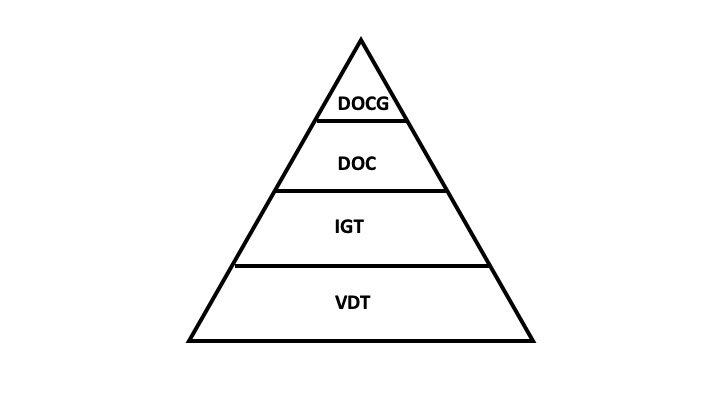Italian wines, like French and Spanish wines, have certain restrictions and laws regarding their production. These Italian regulations result in their wines being classified into four official tiers.
While you’ll find the producer’s name, appellation, vintage and alcoholic content on the label of an Italian wine, you’re also likely to find its official classification there too. These classifications are a guide to their quality.
In the 1960s, Italy began its wine classifications with heavy influence from the appellation system used by their northern wine neighbors in France.
Italy began with the DOC and DOCG categories and then created the IGT category in the early 1990s.
Italy’s four official tiers of wine classifications are as follows:
DOCG (Denominazione di Origine Controllata e Garantita) — This is the highest classification for Italian wines. There are more than 7 DOCG wines in Italy, most of them from the regions of Piemonte, Tuscany, and Veneto. The controls (controllata) for these wines include the methods used in wine production and provides a guarantee (garantita) of the wine’s quality. The strict rules imposed on a DOCG wine include the allowable grape varieties, limits its production (yield), defines the necessary grape ripeness for harvest, specifies the winemaking procedures and finally, defines aging requirements on barrels and bottle before a wine is released to the market. These wines are also subject to official tasting procedures. As an added guarantee, and to prevent counterfeiting, you’ll find that these bottles have a numbered government paper seal on the neck.
DOC (Denominazione di Origine Controllata) — This is the primary tier of Italian wines and covers nearly all traditional Italian wine style. There are more than 300 DOC titles in Italy, each having its own unique set of laws governing their wines. These laws include the viticultural zone, the grape varieties and the wine’s style. These wine also have an official paper seal on the neck of the bottle.
IGT (Indicazione Geografica Tipica) — This classification was introduced in 1992 allowing certain freedoms to Italian winemakers. This classification focuses on the region of origin, much like the AVA system in the U.S., rather than grape varieties or wine styles. It has significantly helped Italian wine makes who produced wine from grape varieties, or blends of grapes, not allowed under the DOCG and DOC classifications.
VDT (Vino da Tavola) — This is the most basic category of Italian wines. Meaning 'table wine' this category is the lowest tier. Table wines can be made from grapes grown anywhere in Italy and are rarely of high enough quality to be exported.
Within each of the tiers you may also see the words “Classico,” “Superiore” and “Riserva” which also have regulated meanings:
Classico: These wines are made in the original historic center of a wine-producing region. Examples include Chianti Classico and Valpolicella Classico.
Superiore: These wines wines are of higher quality often because of higher alcohol (typically at least 0.5% higher) than the minimum required and/or it has been aged longer than required.
Riserva: These are aged longer than typical. Generally, for at least two years.


